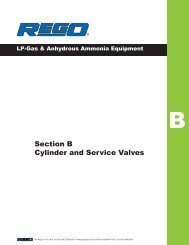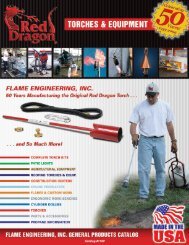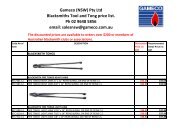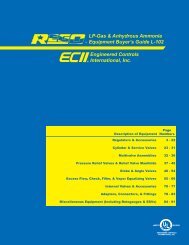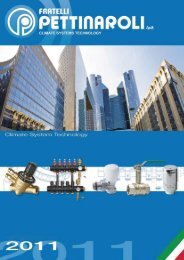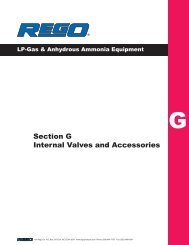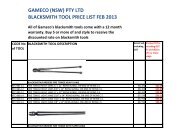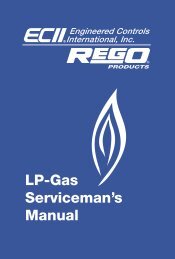Repair Kits Available By Part Number Section 2 Page - GAMECO
Repair Kits Available By Part Number Section 2 Page - GAMECO
Repair Kits Available By Part Number Section 2 Page - GAMECO
You also want an ePaper? Increase the reach of your titles
YUMPU automatically turns print PDFs into web optimized ePapers that Google loves.
WARNING: Installation, usage and maintenance of this product<br />
must be in compliance with all Engineered Controls International,<br />
Inc. instructions as well as requirements and provisions of NFPA<br />
#54, NFPA #58, DOT, ANSI, all applicable federal, state, provincial<br />
and local standards, codes, regulations and laws.<br />
Inspection and maintenance on a periodic basis is essential.<br />
Installation and maintenance should be performed only by<br />
qualified personnel.<br />
Be sure all instructions are read and understood before<br />
installation, operation and maintenance. These instructions must<br />
be passed along to the end user of the product.<br />
CAUTION: Contact or inhalation of liquid propane, ammonia<br />
and their vapors can cause serious injury or death! NH3 and<br />
LP-Gas must be released outdoors in air currents that will<br />
insure dispersion to prevent exposure to people and livestock.<br />
LP-Gas must be kept far enough from any open flame or other<br />
source of ignition to prevent fire or explosion! LP-Gas is<br />
heavier than air and will not disperse or evaporate rapidly<br />
if released in still air.<br />
1. The 3121 Unloading Adapter is designed to provide a simple,<br />
safe means of container evacuation provided these instructions<br />
are carefully followed.<br />
NOTE: On the 3121, it is recommended that a 3 /4" shut-off valve<br />
be installed at opening “G” – between the unloading adapter<br />
and the hose.<br />
2. This unloading adapter is usable with the 2418, 2550, 2555,<br />
2557, 1475, 2593, 2594, 8593, 8594 and 8475 MultiValves and<br />
the 3178, 3179, 7579 and 7579P quick filler valves.<br />
3. The filler check valves of the 3178, 2418, 2550 and current<br />
2555 and 2557 (see paragraph 6 (f) for earlier production of 2555<br />
and 2557) require only 1 /4" movement to open both upper and<br />
lower check valves. Such filler valves are identified by a single<br />
V-groove cut across the hex corners of the body.<br />
4. Valves 1475, 2593, 2594, 8593, 8594, 8475, 7579 and 7579P<br />
require a movement of approximately 1 /2" to fully open both<br />
upper and lower filler check valves. Since 1 /4" movement of<br />
the upper check valve is required before the lower check valve<br />
is opened, the lower check can still close even though upper<br />
3121<br />
Unloading Adapter<br />
Installation and Operation<br />
check is held open by foreign matter. Such filler valves are<br />
identified by a double V-groove cut across the hex corners<br />
of the body.<br />
5. Before attempting to use the adapter it is of vital importance<br />
that you first make sure:<br />
a. That the filler valve on a container to be evacuated is<br />
equipped with a dip pipe extending to the bottom of the<br />
container.<br />
b. That if the container is equipped with a filler valve with a<br />
supplementary back pressure check valve - the design of<br />
the combination must be such that the lower valve (back<br />
pressure check) also opens when the upper valve (filler) is<br />
pushed open. All of the combination and back pressure check<br />
valves listed above meet this requirement.<br />
c. That the unloading adapter assembly is not connected<br />
to the hose.<br />
6. After following instructions outlined in paragraph 5, the following<br />
operating instructions must be followed to operate the unloading<br />
adapter correctly and safely.<br />
a. Place handwheel in full clockwise or close position The<br />
handwheel rises out of the valve body when placed in the<br />
closed position.<br />
b. Place adapter on valve and tighten coupling nut.<br />
c. Connect unloading hose to opening G or shut-off valve<br />
assembly.<br />
d. Turn handwheel in counter clockwise or open position.<br />
e. After contact with the plunger stem has occured, continue<br />
opening valve very slowly by turning the handwheel open.<br />
Handwheel<br />
(shown in closed position)<br />
3/4" NPT Thread<br />
(attaches to supplementary<br />
3/4" shut-off valve)<br />
Valve Vent<br />
(E)<br />
Coupling Nut<br />
Opening<br />
(G)<br />
1 3/4" Acme Thread<br />
(attaches to filler valve)



